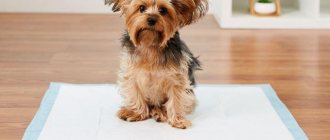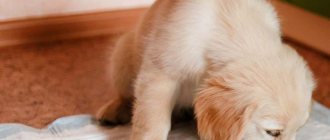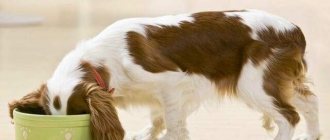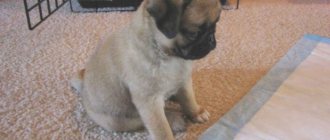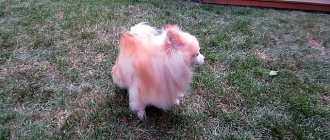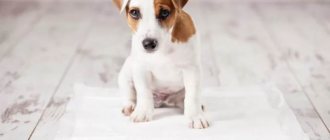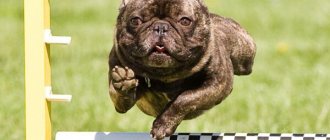Content
1. Is it necessary 2. Tray or diaper? 3. At what age should you train it 4. How to train a 1.5-2 month old puppy to wear a diaper 5. How to train a 3 month old puppy to wear a diaper 6. Expert advice 7. Video:
If you take a very small puppy into your home, you should be prepared for the fact that it will be difficult for him to endure before walking, and small troubles will be inevitable. Well, for dogs of miniature breeds this problem can persist until adulthood. Therefore, it is necessary to know how to accustom a puppy to a diaper even before he appears in the house.
Is this necessary?
Surveys of dog owners show that for half (51%) of them, the problem of teaching dogs to be clean remains relevant even when the pet has already grown out of puppyhood. A quarter of dog breeders have trained their pet to relieve its natural needs only in a diaper or in a tray, and another 14% walk the dog, but if this is not possible, the pet can go to the toilet in a diaper or in a tray. And only 7% of respondents tolerate their dogs calmly until walking. In the latter case we are talking about dogs of large and medium breeds.
How the issue of toileting for the puppy will be resolved should be decided before it arrives in the house. It is good if it is possible to walk your pet several times a day - when these duties can be performed, for example, by several family members. When the owners work all day, the little puppy will not be able to wait until they come home. Therefore, it is more convenient to teach him to go to the toilet in a diaper.
Tray or diaper?
A puppy is not a cat; it has different physiological characteristics and instincts. The kitten digs diligently in the litter box, the puppy calmly does its business and runs on to play, without focusing either on the process or on hiding its results. Therefore, there is not much difference in whether to accustom a dog to a diaper or a tray.
Pet stores have special diapers and bedding for puppies. They absorb moisture well and do not leak. Diapers prevent the spread of odors, which allows you to keep the house clean, even if the owners have to be away from work all day.
Such diapers are made from non-toxic, hypoallergenic materials that are harmless to animals and the environment. They can be used at home, during a trip, and at an exhibition.
Trays for dogs are different from those for cats. They have frames for a diaper or grass mat, and trays with posts are made for male dogs. The ability to change diapers and mats in the tray helps maintain hygiene.
Important!
Breeders, as a rule, are engaged in accustoming puppies to a diaper from early childhood, however, once in a new home, the puppy may become confused, and all skills will need to be re-instilled.
Diapers for dogs
They are divided into two main varieties.
Disposable
They are simpler and not designed for long-term use.
Reusable
They cost more, but it pays off over time, because one such diaper can last for several hundred machine washes. Accustoming them to them is easier, because the puppy will recognize his diaper, while a disposable diaper is new every time.
The materials used for them are different: the simplest ones are made of flannel, there are also more advanced options like easy-to-clean foam synthetics.
At what age should you teach
Cleanliness and hygiene are two fundamental factors for keeping a pet in the house, so a puppy should be accustomed to a diaper as soon as it appears in the family. The older the dog, the more difficult it is to instill cleanliness in it, so the learning process will be longer and more complex.
But in very small puppies (1-2 months old), urination is frequent and often uncontrollable. Puppies begin to tolerate and control physiological processes in their bodies at 4-5 months. Therefore, many experts believe that toilet training in puppies will be most effective at the age of 3-4 months. Usually at this age they buy puppies from breeders.
However, if the baby has not reached 3 months of age, there is no need to wait. The learning process will just take longer and require patience.
How to diaper a 1.5-2 month old puppy
Puppies do not have innate toilet instincts. The only understanding in the little puppy head concerns the fact that you can’t shit where you sleep and eat. The four-legged baby can perceive the rest of the space as a potential toilet. Therefore, it is advisable to remove all carpets from the floor that could be damaged by a small puppy.
The process of accustoming a puppy to a diaper or tray consists of several stages. At first, it is recommended to limit the living space for the animal within one room, for example, a room. This is necessary so that as few things as possible in the house are damaged, and for a small pet the process of adaptation to a new home will be easier.
Watch carefully when the puppy makes puddles. This usually occurs spontaneously after eating, sleeping, or playing. At these moments, be extremely careful and immediately take the puppy to the designated toilet area. At first, you should do this every hour. Wait for him to do his business and be sure to praise him. Only encouragement can achieve good results.
Important!
Do not scold the puppy if he makes a puddle in the wrong place. He is still small, and it is not his fault what happened. The pet does not understand what is expected of him.
If you reward your puppy after he goes to the toilet in his diaper, he will later understand what to do to get a treat. In addition, animals read emotions well, so the puppy will immediately feel the upset look of the owner and the tone of his speech.
It will take some time for the pet to accurately perform all the actions - manage to run to the diaper and do its business in it. Therefore, be patient, bring your actions to automatism: the puppy has eaten - we carry it to the diaper, give it a treat, wakes up - we carry it again, we encourage it. And so on day after day, until one day you see that the pet itself is skipping to the toilet, and then waiting for a treat.
Sometimes puppies don’t like the designated place for the toilet, and he stubbornly chooses another corner. The best option to overcome such stubbornness is to put the diapers in several places and observe. If the puppy prefers the same place, remove the remaining bedding and gradually move the “favorite” to the place that is more convenient for you. When there are no more mistakes, you can put a tray and put a diaper in it. Over time, it may be possible to do without it, when the pet absolutely begins to perform the actions required of it (not for a treat, but instinctively).
How to work with learning difficulties
- Place several diapers in those places where the dog most often misses. Gradually remove the less popular ones, those that the puppy uses less often.
- Pay attention to which diaper the dog wears most often. Perhaps he tells you the most comfortable place for him.
- If the puppy regularly misses and walks to the edge of the designated area or nearby, try buying a larger oilcloth or placing two nearby.
- If your baby tears up disposable bedding, plays with it, or drags it around the room, don’t swear. This is normal and natural for the baby. Offer him other toys, glue the bedding to the floor with masking tape for a while, so they will not rustle and provoke the dog.
- If the puppy refuses to poop in the diaper, watch the dog more closely, catch and take it to the designated place on time, and when it does, be sure to praise it.
We advise you to read: Which food is best for puppies
How to diaper train a 3 month old puppy
3-4 month old dogs are already able to control their physiological needs. If a dog appears in your home at this age, you can already train it to go to the toilet outside. True, you will have to walk the puppy several times a day - at least four: after meals, after sleep.
Not all pet owners have these options. If the owner and his family members are away from home all day, it is best to accustom the pet to a litter box, which he can use during the day and walk outside in the morning and evening. Therefore, it is advisable that the dog does not get lost in such a situation - it can use a tray or diaper if necessary.
Important!
Teach your dog commands: “Walk!”, “Toilet!” The latter will come in handy if, due to some circumstances, a walk is impossible, so the dog can relieve itself on the diaper.
You can control the process if you accustom the dog to a daily routine, feed it at the same time, and walk it at certain hours. If a growing puppy asks to go outside to the toilet, take him to the litter box and command: “Go to the toilet!”
These methods are also suitable for cases when an adult dog has appeared in the house. Even if she was litter box trained in her previous home, she may have to start the whole training process all over again.
Pros and cons of using diapers
The following table will help you understand the pros and cons of using dog litter diapers:
| The benefits of using diapers | Minuses |
| 1. An opportunity to get rid of puddles and unpleasant odors in the apartment during the younger puppyhood. | 1. It will take longer to retrain the puppy for the outdoors than initially for the diaper. |
| 2. The ability to relieve yourself at home in bad weather (frost, strong wind, rain, etc.). | 2. A minimal smell will still be present in the apartment, regardless of cleaning. |
| 3. Using a diaper when there is no free time for walking. | 3. Urine leakage through the diaper onto the carpet or linoleum, laminate, etc. |
| 4. Excellent insurance when your pet is ill (when it is dangerous or not recommended to walk him). | 4. Lack of a dog’s daily routine (when I want, then I relieve myself). |
| 5. The ability to relieve himself at home until the dog gets used to the walking overalls. | 5. Breaking the tradition of walking together (for an adult dog). |
| 6. A large assortment of diapers on sale. | 6. Additional costs. |
Expert advice
Raising a dog is a long process. Patience is the main assistant in training a dog to use a tray and a diaper. Canine specialists give their recommendations on how to help your pet and keep the house clean:
- You can use special products that are sold in pet stores. There are sprays for toilet training and those that have the opposite effect - they scare the animal away from unsuitable places;
- The “carrot and stick” method in relation to small puppies should be replaced with “carrot”: try to praise your pet if he went to the toilet in a diaper, but in case of annoying mistakes, do not rush to scold and punish. By the owner’s distressed voice, the puppy will understand that he was wrong;
- a pet may consider such methods cruel, but you can stop your dog from crapping in inappropriate places by placing a bowl of water or food there. It is taboo for pets to relieve themselves where they eat.
Important!
Scolding a dog for already making a puddle is useless. It is unlikely that the pet will understand why the owner is angry with him. Reprimand (vocally, but not screaming!) may only be appropriate if the puppy is “caught in the act”
All pet owners face the problem of toilet training. Usually breeders begin to teach cleanliness, but once in a new home, the dog may behave differently. And some puppies will need a minimum of time to adapt, while others will have to be taken to the litter box for a long time after eating and sleeping, waiting for the little dog to relieve itself. But patience will help solve the problem, and the grown puppy will ask to go outside without any problems.
Features of training different breeds
The training technique is the same for everyone, but sometimes it is necessary to take into account some breed characteristics. The owners will have to master these nuances:
- Yorkshire Terriers. Yorkies are initially limited in their free space. Otherwise, training will be greatly delayed. Cover a small enclosure with diapers and equip it with everything you need.
- Husky. Puppies of this breed take a long time to learn on their own. They are raised by their mother until they are six months old. With earlier weaning, all worries are assigned to the owner. Breeders recommend accustoming them to newspaper, since otherwise any soft surface will be affected.
- Toy terriers and chihuahuas. The accelerated metabolism of these dogs results in frequent urination. They will have to be placed on the litter after each feeding. If you wet it a little with warm water, your pet’s urination reflex will work. Pets are good at capturing their owner’s mood, so they understand well what they want from them.
- Shpitsev. These curious dogs love to explore the world. You won't be able to keep them in the playpen, so stock up on reusable products that can cover most of your apartment.
- Labradors. Labradors are among the ten most intelligent dogs, quickly learn commands and understand their owner well. If you try to relieve yourself in the wrong place, say “No” or “Ugh”, pick up your pet and move it to the required place. If you succeed, don't forget about encouragement.
When purchasing a puppy, ask the breeder for your pet's personal diaper. Even a habituated animal gets lost in a new territory. A familiar smell will guide you in the right direction and prevent mistakes.
